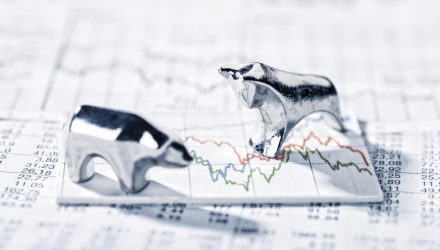Exchange traded fund investors can consider a Defined Outcome strategy with a built-in buffer in play that could help better diversify portfolios and manage market risks.
On the recent webcast, Buffer ETFs to Capitalize on Market Volatility, Bruce Bond Co-Founder and CEO, Innovator ETFs; and Graham Day, Vice President of Product and Research, Innovator ETFs, outlined an alternative investment strategy that incorporate an innate buffer to limit potential downside risks but still maintain some upside potential once stocks turn around.
The Innovator Series is based on the idea of trading known downside buffer for unknown outperformance potential. Specifically, they explain that the loss aversion principle states that the disutility of losing an object is two times greater than the utility of acquiring. Hence, investors remember losses more acutely than gains.
Bond highlighted the ongoing demand for downside risk mitigation as investors have piled on $3.2 trillion into hedge funds and $1 trillion into equity-linked structured products. However, he argued that these solutions, notably products issued by insurance companies and banks, often fail to deliver downside protection and are also come in sub-optimal investment wrappers.
Getting That Downside Buffer
Specifically, Bond argued that bonds might not provide the downside buffer investors are historically accustomed to with credit risk exposures. Hedge funds are expensive, have spotty track records over the last market cycle, and come with high minimums. Shorting the market typically comes with high carry costs, limited upside exposure, and requires the ability to time the markets well. Additionally, the ability to access insurance and bank products typically is only available through agents or brokers.
Alternatively, investors can look to Innovator’s Defined Outcome ETFs, which come with no credit risk, intra-day liquidity, no surrender fees, access on an exchange, no commissions, and lower fees. Specifically, Innovator ETFs has come out with a suite of Defined Outcome ETF strategies with a build-in buffer to help investors hedge against risks ahead, depending on one’s level of risk aversion.
For example, the January series includes the Innovator S&P 500 BUFFER ETF (BAPR), Innovator S&P 500 POWER BUFFER ETF (PAPR), and Innovator S&P 500 ULTRA BUFFER ETF (UAPR), which have a 9%, 15%, and 30% buffer, respectively.
The Defined Outcome ETFs provide market exposure with a built-in downside buffer. The ETFs start with a synthetic 1 to 1 exposure to the target market. They would then include a put spread to provide targeted buffers of 9%, 15%, or 30% to their respective targets. Lastly, the upside is capped by selling an upside call to finance downside buffers.
While the quarterly Defined Outcome ETF series is set up with an annual target, investors can still invest in a series of intra-period.
So far, these buffer ETF strategies are doing precisely what they promised to do: limit drawdowns during periods of heightened volatility.
For example, looking at the January series that includes the Innovator S&P 500 Buffer ETF (BJAN), Innovator S&P 500 Power Buffer ETF (PJAN) and Innovator S&P 500 Ultra Buffer ETF (UJAN), the strategies have exhibited lower drawdowns and experienced lower overall volatility when compared to the benchmark S&P 500 year-to-date. Specifically, BJAN only saw 80% of the S&P 500’s drawdown and experienced 77% of the benchmark’s volatility. PJAN showed 63% of the S&P 500’s drawdown and 57% of the S&P 500’s volatility. Lastly, UJAN showed 46% of the drawdown and 41% of the volatility.
There are various ways for investors to incorporate buffer ETFs into a diversified portfolio. Investors can add them as a bond alternative, stay invested while mitigating further volatility ahead, avoid timing the markets to remain invested, and put your cash to work with a known buffer in place.
Financial advisors who are interested in learning more about buffer ETF strategies can watch the webcast here on demand.
